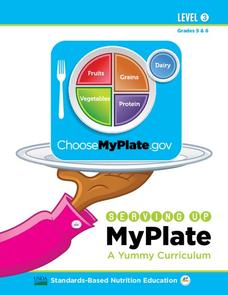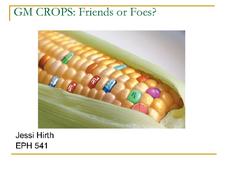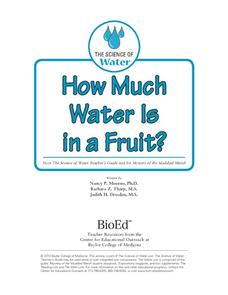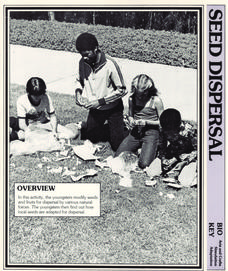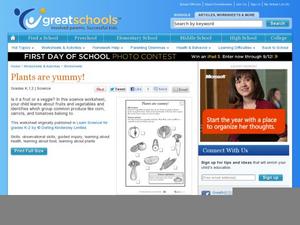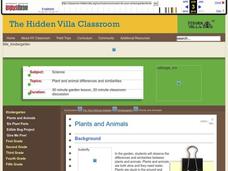Rainforest Alliance
A Rainforest Taste Test
Take a taste test and chart pupils' favorites with a delicious fruit salad made up of fruit found in the rainforest. Still hungry? Snack on the rainforest inspired trail mix using a recipe of dried fruit and nuts.
Cooking Matters
Breakfast Boost
A healthy and balanced breakfast is essential to maintaining a day's worth of solid energy and mind-power. Encourage class members to eat a smart breakfast with a worksheet that provides interesting food facts, a questionnaire looking...
Cooking Matters
Sugar Shocker
A well-balanced meal is crucial to living a healthy lifestyle. Support healthy living with a worksheet that focuses on the amount of sugar we find in our food. The packet begins with an overview, then goes into an activity in which...
Houghton Mifflin Harcourt
Nature Walk: English Language Development Lessons (Theme 2)
Walking in nature is the theme of a unit designed to support English language development lessons. Scholars look, write, speak, and move to explore topics such as camping, woodland animals, instruments, bodies of water, things found at a...
US Department of Agriculture
Serving Up My Plate
Within three nutrition-themed, inquiry-based learning opportunities, pupils take notice of their eating habits; delve deep into the five food groups, gain experience in planning meals, participate in a taste test, and explore ads from...
Curated OER
GM Crops: Friends or Foes?
Genetically modified crops—How do you feel about them? Here, explore the benefits and risks of GM crops to inform your opinion.
Curated OER
Elementary Vocabulary Games
How do learners pick up new vocabulary words? This book offers an explanation and 30 vocabulary games to help your language learners master new words. Each game is based on a particular topic and includes three parts (memorizing,...
FloridaHealth
The Very Hungry Caterpillar
Invite that hungry caterpillar to teach your class about nutrition! After brief instruction on fruit, the teacher reads The Very Hungry Caterpillar by Eric Carle to the class. Kids hold up the fruit images at appropriate points in the...
Baylor College
How Much Water Is in a Fruit?
Compare the volume of an orange to the volume of liquid that can be extracted out of it. Also compare the mass of an apple before and after it has been dried out. In both of these activities, children find that there is an appreciable...
Curated OER
What Category do I Best Fit Into?
Use this pre-reading exercise to help learners sort familiar objects into categories. For each of these three sets, they draw a line from the object to the category in which it belongs. There are two categories for each set. If scholars...
Curated OER
Picture and Word Match: Fruit
How do you say watermelon in Spanish? Young learners match the Spanish words with the six pictures shown. They'll review the translation for grapes, banana, watermelon, pear, plum, and strawberry.
Curated OER
Couch Potato
Show your class that being active is more fun than being a couch potato! A fun tag game teachers learners about making healthy eating choices. Over 125,000 teachers have reviewed this activity, and many have written comments about how...
Curated OER
Fruits and Vegetables
Here is a fun way to investigate fruits and vegetables. In this healthy diet and reading lesson, learners read and recite several poems about fruits and vegetables. They sort pictures and word cards with assorted names of fruits and...
Curated OER
Seed Dispersal
Young scholars disperse seeds. For this Science lesson, students experiment with various ways to naturally disperse seeds. Young scholars evaluate the effectiveness of the various ways to disperse seeds.
Primary Resources
Eating a Balanced Diet
A perky presentation provides an overview of what comprises a balanced diet. Viewers discover why water is vital to our health, what the macro-nutrients are and what they provide, and how calcium is important to bones and teeth. The...
Biology Junction
Seed Plants: Gymnosperms and Angiosperms
One of the reasons plants found success on land relates to seed development. Scholars learn about many different forms of seeds and how they changed over time. It describes the structure and function of many different types of seeds in...
US Apple Association
Apples: A Class Act! (Grades Pre-K–3)
Discover the nutritional wonders of apples and get to know Johnny Appleseed with a plethora of learning experiences that cover subjects math, history, English language arts, health, and arts and crafts. Activities include an apple...
Curated OER
4th Grade Food Safety Lesson
From a high-speed hand-washing lesson to identifying important nutrients in fruits and veggies, this resource has several activity ideas and worksheets for teaching food safety to your learners.
Curated OER
Plants are yummy!
Is it a fruit or a vegetable? Youngsters place an F next to each fruit they see and a V next to the vegetables. Corn is tricky. It is a grass, so it's actually not a fruit or a vegetable, but a grain!
Curated OER
Simply Salad Poems
Young scholars investigate the concept of healthy fruits and vegetables. They conduct an information search to list the health benefits of eating vegetables. Students use the information in order to create drawings based around the theme...
Curated OER
Rename Fruits, Vegetables and Spices
Students explore fruits and vegetables. In this fruits and vegetables lesson, students study traits of various fruits, vegetables and seeds. Students rename fruits, vegetables and seeds.
Curated OER
Fabulous Fruits
Students identify several fruits, research nutrition information about each of them, and compare and contrast their findings. They design thank-you cards by creating soft color was images of fruits. They then write thank-you notes to...
Curated OER
What Parts of a Plant Do We Eat?
Did you know that tomtoes and cucumbers are actually fruits? Biology or botany beginners read about the function of flowers and fruit and find that some food items commonly called vegetables are, by definition, also fruits! Give learners...
Curated OER
Plants and Animals
Students taste test the garden. In this Science lesson, students compare and contrast plants and animals needs. Students pick fruits and vegetables in the garden and discuss their observations.






